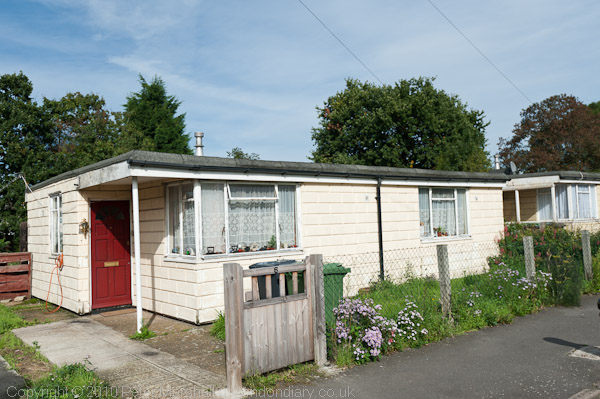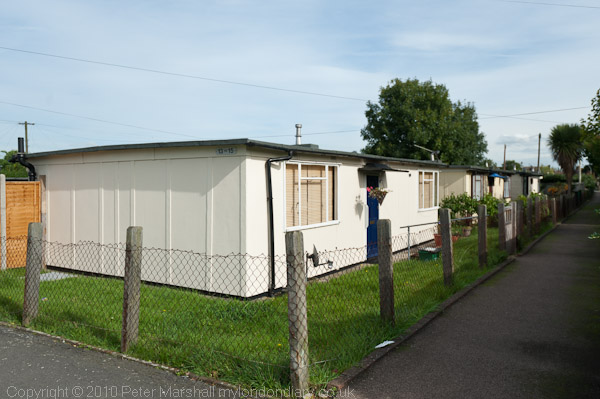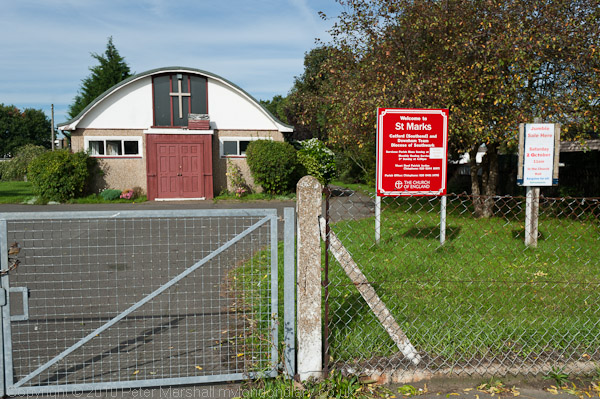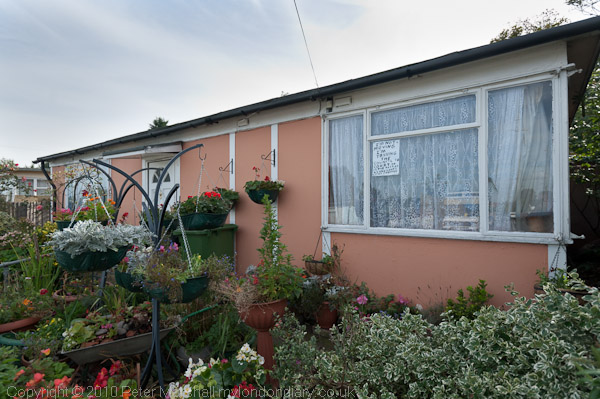
UniSeco Mark 2 Prefab on the Excalibur Estate
On Thursday I got on my bike and cycled from Waterloo Station to the Excalibur Estate at Downham in Catford, whose streets are named after knights of the Arthurian Round Table. This is the only large example remaining of a number of prefab estates constructed as the Second World War ended for returning soldiers and their family. Although intended as temporary dwellings, they were basically well-made and equipped with all mod cons including fitted kitchens, refrigerators, built-in cupboards and heated towel rails.
For many years now, Lewisham Council has left the maintenance of these bungalows to the residents, and a few of them, along with rather more who have bought their homes, have made a real effort to keep them in good order.
Where tenants or owners – past or present – haven’t taken over the council’s responsibilities, these homes are in often in very poor condition. So bad that when residents move or die, they are no longer re-let, but allowed to become derelict.
As you can hear on a slide show at The Guardian, for the first residents who moved to these properties were impressed by the standard of the accommodation they offered, and the standards set by the Ministry of Works were high- more modern properties are built to rather meaner specifications. The minimum floor area was 635 square feet, though I think these are a little larger, and some have now been extended. Although they were meant to cost £500 each, the actual cost of these was, made by the Selection Engineering Company Ltd was well over a thousand pounds – some things don’t change.
One of the designers of the kitchens in the ‘service units’ – kitchen and bathroom – was the Czech industrial designer George Fejer who worked on them from 1943, and later was one of the team that worked at Hygena creating the British style of fitted kitchen.

UniSeco Mark 3 Prefab on the Excalibur Estate
The UniSeco design – and around 29,000 were built – was perhaps the most innovative of all the various prefab designs built, with a distinctive modernist look, for example in the joined corner windows and the almost flat roofs.

St Marks Downham – the council is talking to the Church of England about its future
The Excalibur estate, with 187 UniSeco Mark II or Mark III units and a prefabricated church – St Marks Downham – and church hall was assembled by German and Italian prisoners of war in 1945-6 on an area of public open space for the neighbouring Downham estate – with the promise that after the 10 or so years these temporary buildings were to last it would be returned as open space. For some years Lewisham council have wanted to demolish the lot and build new social housing on the entire site.
It is the only large prefab estate remaining, and residents and others pressed for its preservation and listing. English Heritage had advised the listing of 21 of the units, which would have enabled something of the character of the estate to be retained if on a much smaller scale. The Department for Culture Media and Sport reduced this to six; four Mark IIs and two Mark IIIs, which although retaining these individual buildings will loose any real sense of the estate, although those chosen are a compact group and were selected because they were relatively unaltered – while some others have undergone considerable ‘modernisation.’ It still is not clear whether or not the church will be retained, though in any case it is of rather less interest.
One of the problems of renovating prefabs of this type is the large amount of asbestos sheeting and cement used in their construction, covering the timber and plywood frame.
I first came across and photographed the estate while walking the Greenwich meridian around 15 years ago – it runs through the middle of the estate – and was impressed by the feeling of openness and space. As some of the residents say, living there is the nearest thing to living in a village you can have in London, and some have made their homes look rather like country cottages, surrounded by flowers. Many have lived there for a very long time.

One of the residents who doesn’t want to move – the sign says he’ll take the council to court
Others on the estate want to get out and live in something more modern and better maintained, and there appear to be two fairly well defined camps. Lewisham, having promised for several years to consult residents finally organised a vote this year, and the results, announced in August were 114 votes for demolition and regeneration with 89 against, with 21 of those entitled to vote not doing so.
Although the time-scale isn’t clear, the council are going ahead with the scheme which involves transfer to a housing association who will carry out the redevelopment. Current tenants who want to move back to the new estate when it is completed will be allowed to do so.
But I wouldn’t leave it too long if you want to visit the last example of one of our more interesting attempts at providing low-cost housing.